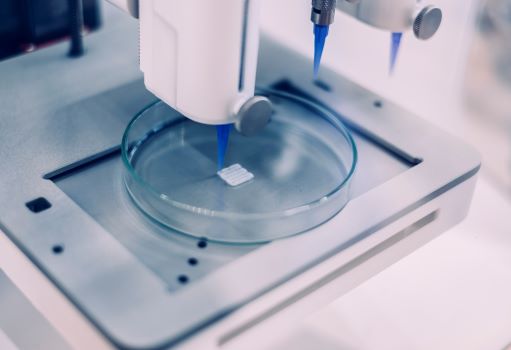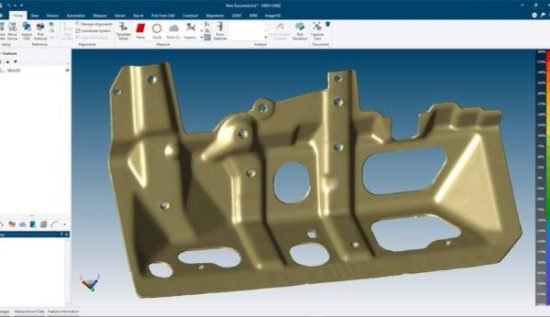Intel Is Building Its Largest 3D Chip Packaging Facility In Malaysia
In the global semiconductor value chain, Malaysia has always been a global center for testing and assembling – and no-one knows that better than Intel Corporation. Intel has been in the Southeast Asian nation for the last 51 years, with Malaysia opening Intel’s first international manufacturing facility in 1972.
ISCAR’s Promising Segment With Five Axis Machining
ISCAR explains how their five-axis machining can be simpler when paired with an optimum portfolio of milling tools.
Faro Launches Enhanced 3D Measurement Software
Faro has released CAM2 2019, an evolution of the well-received CAM2 2018 3D measurement software introduced last year. CAM2 2019 sets a new standard for intelligent metrology via improved ease of use, interactivity, flexibility and targeted, actionable intelligence. In addition to the tight integration with Faro metrology products that enables a seamless user experience, CAM2 2019 extends the narrative for high value interactivity and usability.
For example, 6Probe users are now able to program button configurations and then interact with the software through the device in real time. Additionally, Faro Laser Line Probe users can benefit from immediate visual feedback of part quality via live deviation colour scans. Finally, with built-in universal CAD importer, all major CAD file formats can be directly imported into CAM2, thereby improving the workflow by eliminating the need for time consuming ‘double translations.’
CAM2 2019 features a standard set of software instructions that automatically guide the user through specific operations, visually and audibly. This lowers the bar for the technical expertise required to use Faro 3D measurement solutions, shortens the workflow and allows users to direct their primary focus on the measurement results themselves. Additionally, pre-set scanning profiles further streamline the end to end process by enabling users to select the appropriate scan setting for the specific part type with the click of a button.
CAM2 2018 featured the Repeat Part Management (RPM) Control Centre, an integrated, web-based dashboard reporting tool that delivers real time inspection results and insightful trend analysis in a user-friendly set of adaptable visual reports. Additionally, RPM enables a specific inspection process to be designed once and then repeated and executed by anyone on the factory floor. CAM2 2019 evolves this functionality to actionable intelligence by delivering statistically based graphs and results for trend analysis and predictive alerts. These alerts not only highlight that the measurement target is trending beyond tolerances, but also provide advanced intelligence into the process and why the situation is occurring.
FOLLOW US ON: LinkedIn, Facebook, Twitter
READ MORE IN OUR LATEST ISSUE!
WANT MORE INSIDER NEWS? SUBSCRIBE TO OUR DIGITAL MAGAZINE NOW!
Multi-Robot Solutions Enable High Performance 3D Metal Cutting
Laser applications have been increasing in use as they support lightweight designs. By Dr Torsten Scheller, global director of technology, product management, and research and development, Jenoptik.
LVD: Cadman-SDI Smart Drawing Importer Module
LVD’s new Cadman-SDI module simplifies 2D and 3D CAD file import and calculation of cost drivers so users can quickly and accurately create job estimates.
A CAD drawing file is imported into the module via simple “drag and drop”. Once imported, the file is converted to OSM (Open Sheet Metal) format and stored in the central Cadman database.
Stored OSM files are immediately accessible for all other modules of the Cadman suite for efficient generation of laser, punching, bending programmes and jobs scheduling. All data is visible at a glance on the control screen.
It features the integrated BrisCAD, a robust 3D direct modelling CAD package. BrisCAD allows the 3D drawing to be reviewed in detail, modified or corrected as required.
APMEN Products
CHECK OUT THESE OTHER ARTICLES
● SCHUNK Releases Versatile Clamping Module For Automated Machine Loading
● Siemens: Solid Edge ST9 Software For CAD
● OMAX Presents Waterjet Cutting Technology at EMO 2019
● Hypertherm Releases Major Version Update Of Robotmaster Robot Programming Software
● Hypertherm ProNest 2019
● TRUMPF Is Expanding The Scope Of 3D Printing
● ZEISS Completes GOM Acquisition
● EMO 2019: ANCA To Launch Latest Generation Of ToolRoom Software
● Faro Launches Cobalt Design Structured Light 3D Scanner
● GEFERTEC At EMO: New-Generation Machines And Applications For 3D Metal Printing
WANT MORE INSIDER NEWS? SUBSCRIBE TO OUR DIGITAL MAGAZINE NOW!
FOLLOW US ON: LinkedIn, Facebook, Twitter
A Nested Interest: What Are The Benefits OF Nesting Software?
Faster cutting with good cut quality is just one of the benefits when using nesting software. Amey Save, product application engineer, Hypertherm Asia-Pacific, tells us more.
Nesting is a computer-aided manufacturing application (CAD) application where cut profiles are laid out in the most optimal way to minimise raw material wastage. Nesting software commercially available today also can also be integrated with enterprise resource planning (ERP) and material requirements planning (MRP) software, allowing for even greater flexibility.
Q: What are the benefits of using nesting software, and how do they translate into the shop floor?
Amey Save (AS):Nesting software comes with unique and smart nesting algorithms that optimise the cutting sheet with parts. For instance, it can allow the end user to optimise the metal sheet with different cut parts, while keeping sufficient gaps between each part for good cut quality and heat affected zone, so that all parts nested will have good cut dimensions and cut quality.
In general, the benefits can be translated to the shop floor in the following ways:
- Optimisation of metal sheet with cutting parts:Saving of scrap material results in cost savings for the company.
- Users can select from a series of tested and verified parameters within the software:This results in faster cutting with good cut quality: Saving time and money on secondary work.
- Users can apply machine and process defined for lead-ins and lead-outs:This helps to achieve good cut quality and also reduces machine maintenance. Ultimately, this leads to less downtime and higher production.
- Compatibility with ERP/MRP software:Provides integration with the entire operating process.
Certain software comes with proprietary technologies that have additional benefits. For example, Hypertherm’s nesting software includes True Bevel technology that reduces trial and error in bevel-cutting jobs for mild steel.
Q: Are there any overlooked features that manufacturers can do with nesting technology that turns into improved productivity?
AS: In addition to its core function, advanced nesting software usually comes equipped with certain optional modules, some of which are specific to improving productivity. Some optional modules include:
- Productivity modules.
- Enterprise modules.
- 3D process modules.
- Machine interface modules.
Our productivity modules contain auto nesting, common line, chain, and bridge cutting functions, which enable users to optimise the nesting layout.
A common problem that many companies encounter is having to keep track of remnant (leftover) metal sheet. With an inventory module, this information will be stored in the database and can be used when required.
Q: Nesting software is not “magic”; physical limitations of the machine have to be taken into account. Is there any common consideration and advice that you’d like to give to users?
AS: I would encourage all users to explore and utilise the optional modules that come with the nesting software. With these optional modules, users have the flexibility to create a customised nesting software (by adding modules as per their requirements) that is suited to their unique needs.
Q: Any common misconceptions about nesting software that you would like to clear up?
AS: We have encountered many nesting CAM software users who think that they can perform plate optimisation manually better than utilising auto nesting. In a way they are right, as nesting software cannot be compared with the human brain nesting logic. That said, nesting software is capable of generating layouts in a much shorter time, as opposed to manual nesting by a user, which helps to save time and increase productivity.
Q: At its heart, nesting software is driven by algorithms in order to reduce material wastage. With technology advancing at a breakneck pace, has there been any advancement in that respect, or to nesting software in general?
AS: Definitely, there’s still room for innovation and improvement in nesting software. For instance, nesting software can come with different modes: Auto Nesting, Manual Nesting, and Hybrid nesting which allows auto and manual nesting both can be used by user. This gives users more control over their nesting layout.
Q: Any other thoughts you would like to share with our readers?
AS: In today’s world, having a powerful vehicle is not sufficient. The vehicle needs to come with features that can be adapted to different road conditions, and offer users flexibility and ease of use.
The same applies to cutting machines as well. Having a big cutting machine alone is not enough. It needs to be complemented by powerful nesting CAM software for optimisation of metal sheet, machine space, shop floor, and human resources, in order for users to reap the most benefits and achieve maximum efficiency and productivity.







